Preparing for a Premiere: The Score of Carter’s Piano Sonata Annotated by James Sykes
Marguerite Boland
[ 1 ] In July 2008, while I was visiting Larry Polansky in Hanover, New Hampshire, to view copies of Johanna Beyer’s scores, Larry mentioned that he had found something special he wanted to show me. Thinking that he must have made a new discovery in one of Beyer’s works, I was most surprised and delighted when he presented me with an old photostat of the autograph copy of Elliott Carter’s Piano Sonata. Larry had found it in a box of library scores and books that were being cleared from the Paddock Music Library at Dartmouth College. From the note taped to the inside back cover of the score, it was clear that the copy had belonged to pianist James Sykes (1908-1985). Sykes was professor of music at Dartmouth College from 1953 till his retirement in 1973.(1)https://ead.dartmouth.edu/html/ms1007_fullguide.html He gave the concert premiere of Carter’s Piano Sonata on March 5, 1947 at Times Hall, New York. (The broadcast premiere was given by Webster Aitkin three weeks earlier.)(2)Felix Meyer and Anne Shreffler (eds.), Elliott Carter: A Centennial Portrait in Letters and Documents (Woodbridge: The Boydell Press, 2008), 73.
[ 2 ] The note taped to the inside back cover of this ring bound photostat was written by Carter to Sykes in December 1946, approximately three months prior to Sykes’s performance. In the note, Carter indicates the correction of three accidentals in two measures of the photostat (see Example 1). He also gives performance indications for specific measures of the music: he points out voices that should be emphasized, places where pedal should be avoided and how to articulate notes to leave “harmonies ringing.” Carter also expresses his concern about finding a “good” piano for Sykes to play at their scheduled meeting on January 2, 1947. The detailed suggestions that Carter offers Sykes in this note are characteristic of the attention and care Carter took when working with musicians on performances of his music.
Example 1
Elliott Carter‘s note to James Sykes.
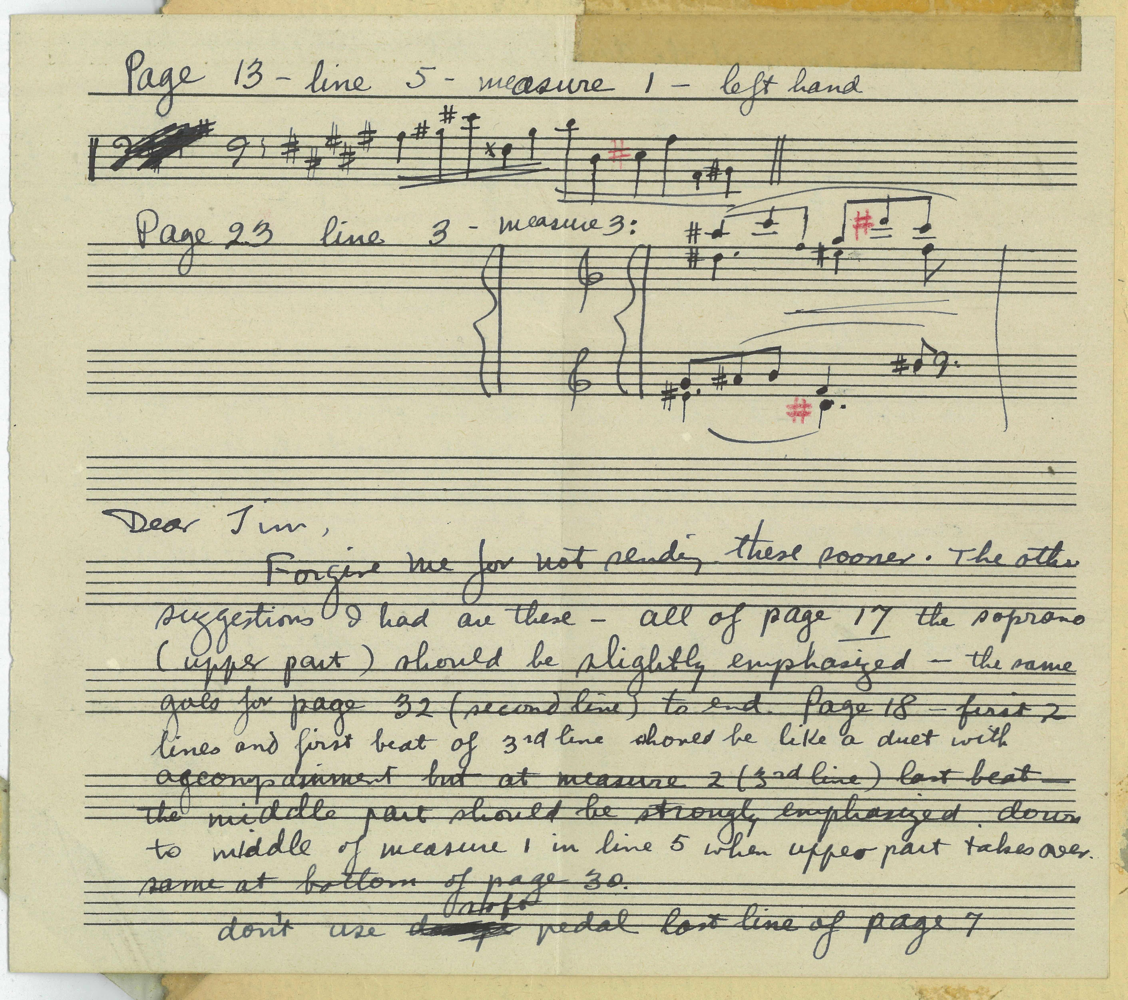
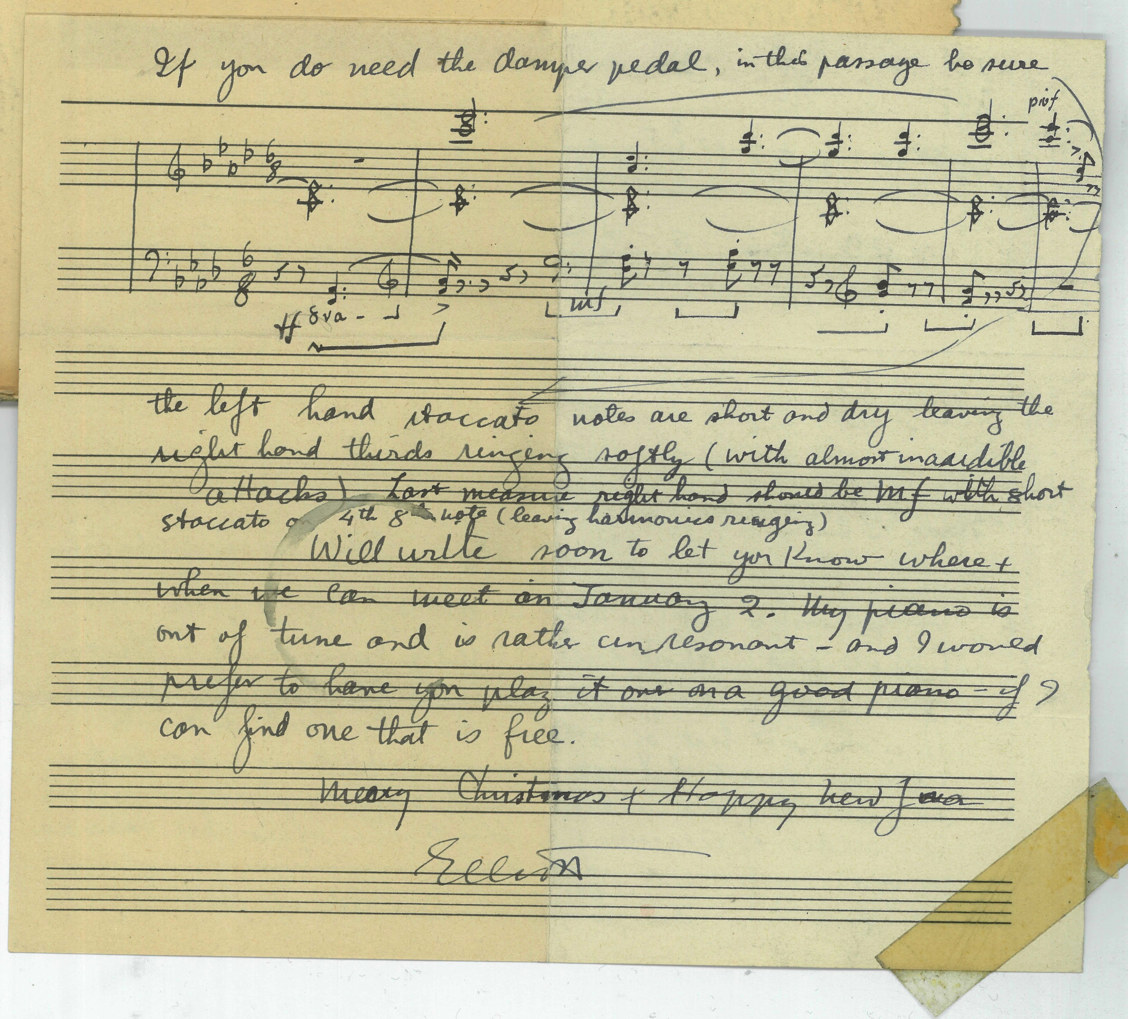
Dear Jim,
Forgive me for not sending these sooner. The other suggestions I had are these – all of page 17 the soprano (upper part) should be slightly emphasized – the same goes for page 32 (second line) to end. Page 18 – first 2 lines and first beat of 3rd line should be like a duet with accompaniment but at measure 2 (3rd line) last beat – the middle part should be strongly emphasized down to middle of measure 1 in line 5 when upper part takes over. same at bottom of page 30.
don’t use damper soft pedal last line of page 7 If you do need the damper pedal, in this passage be sure[score transcription]
the left hand staccato notes are short and dry leaving the right hand thirds singing softly (with almost inaudible attacks) Last measure right hand should be mf with short staccato on 4th 8th note (leaving harmonies ringing)
Will write soon to let you know where + when we can meet on January 2. My piano is out of tune and is rather unresonant – and I would prefer to have you play it once on a good piano – if I can find one that is free.
Merry Christmas + Happy New Year
Elliott
[ 3 ] All the performance indications that Carter provides in the note made their way into Sykes’s score as annotations, as can be seen in Examples 2a-d. But Sykes also annotated the score with many other comments attributed to “(EC).” A few instances as can be seen in Examples 3a-c. We can assume from Sykes’s additional annotations that this particular note was one of several communications, in person or in writing, that Carter and Sykes had about the performance of the piece.
Example 2a
Piano Sonata Photostat, p.17 left margin of first system: “Soprano (upper part) should be slightly emphasized.”
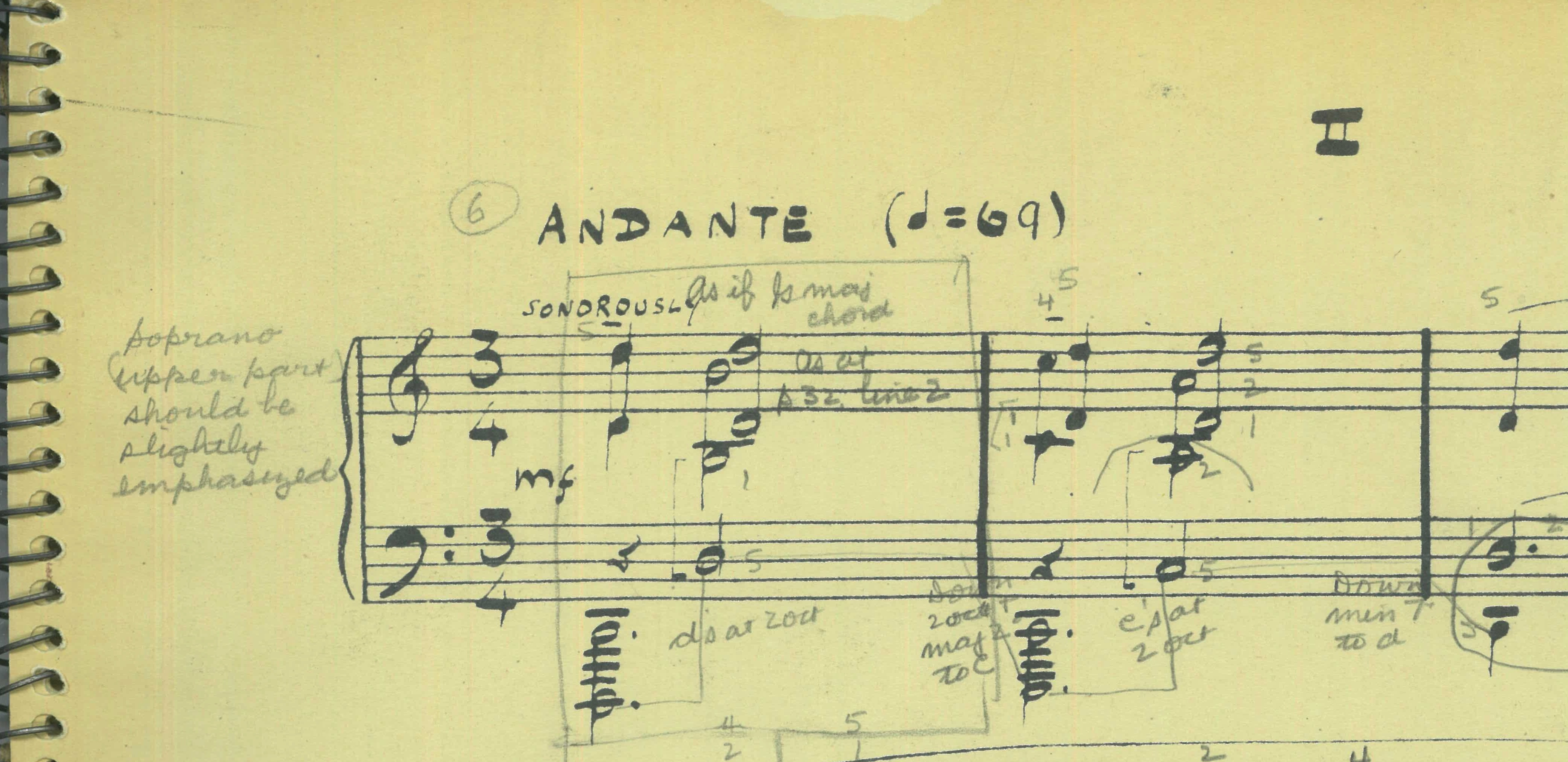
Example 2b
Piano Sonata Photostat, p.32 left margin of system 3: “Soprano (here to end) slightly emphasized.”

Example 2c
Piano Sonata Photostat, p.18 left margin of first system: “1st 2 lines + 1st beat of 3rd line should be like duet with accpt. (E.C.);” p.18 left margin of system 3: “At meas 2 (line 3) last beat mid part should be strongly emphasized down to mid of meas 1 (line 5) when upper part takes over (E.C.)”
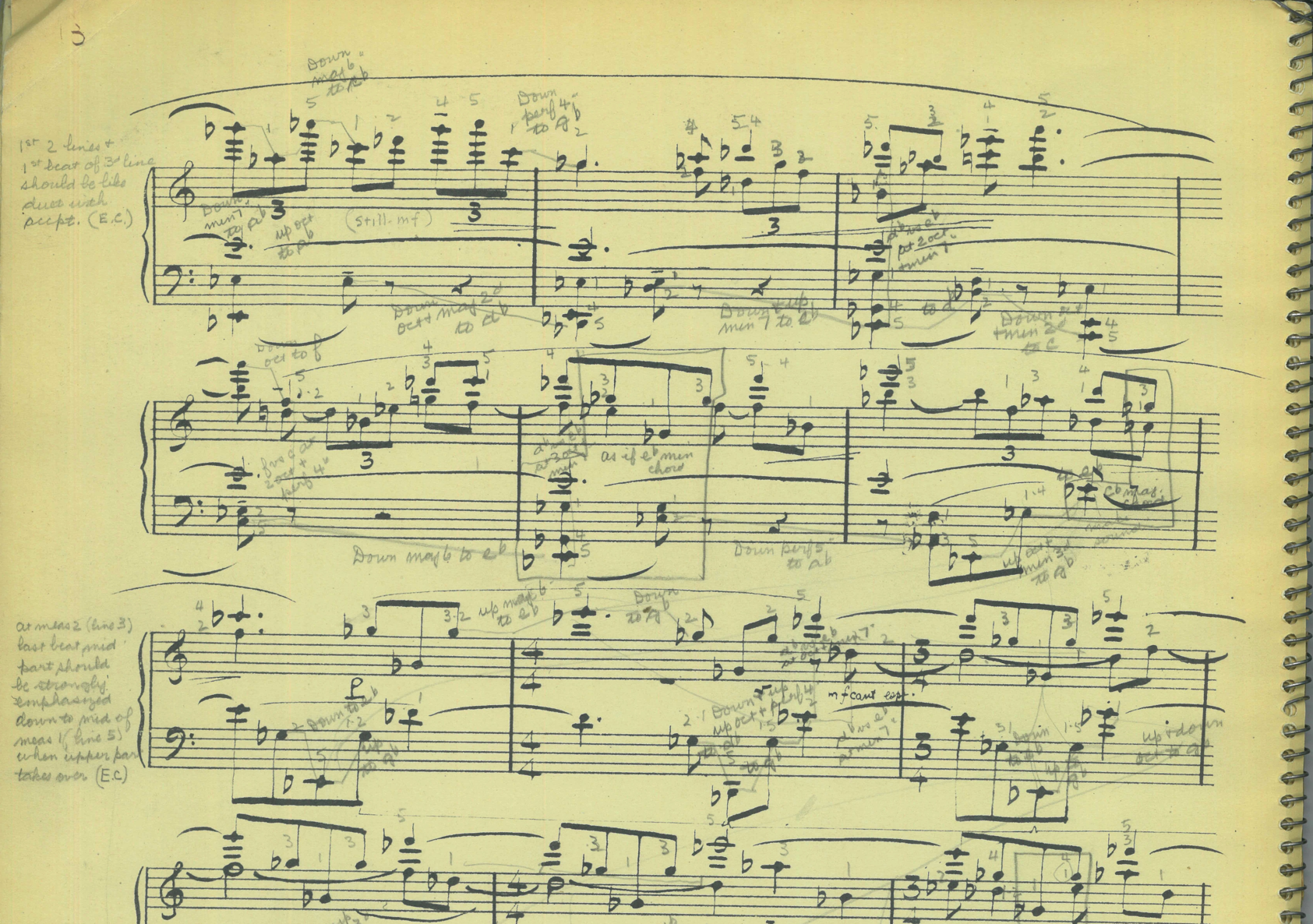
Example 2d
Piano Sonata Photostat, p.7 left margin of last system: “no soft pedal this line, if damper pedal needed be sure LH stacc. notes are short dry leaving RH 3ds ringing softly (with almost inaudible attacks) (E.C.);” Piano Sonata Photostat, p.7 last measure of page: “Should be mf with short stacc on 4: 1/8 leaving harmonies ringing (EC).”

Example 3a
Piano Sonata Photostat, p. 2 left margin: “False entries; culminate in true entry top p 3 [EC].”
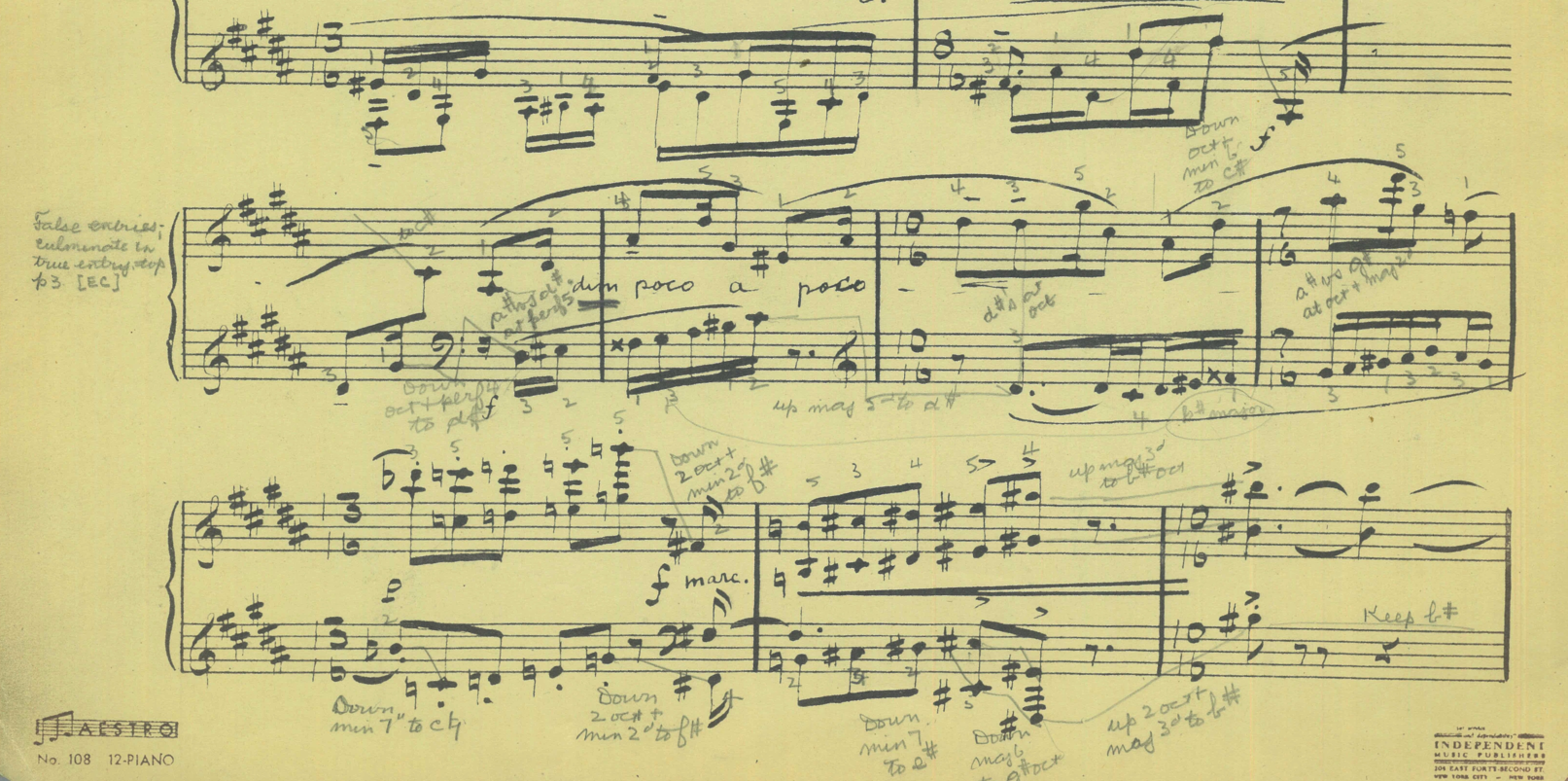
Example 3b
Piano Sonata Photostat, p. 16 first measure of last system: “Hold off before striking (EC).”

Example 3c
Piano Sonata Photostat, p. 19 top margin: “still very intense” and “tumultuous lead directly to Piu mosso, line 3 [EC].”
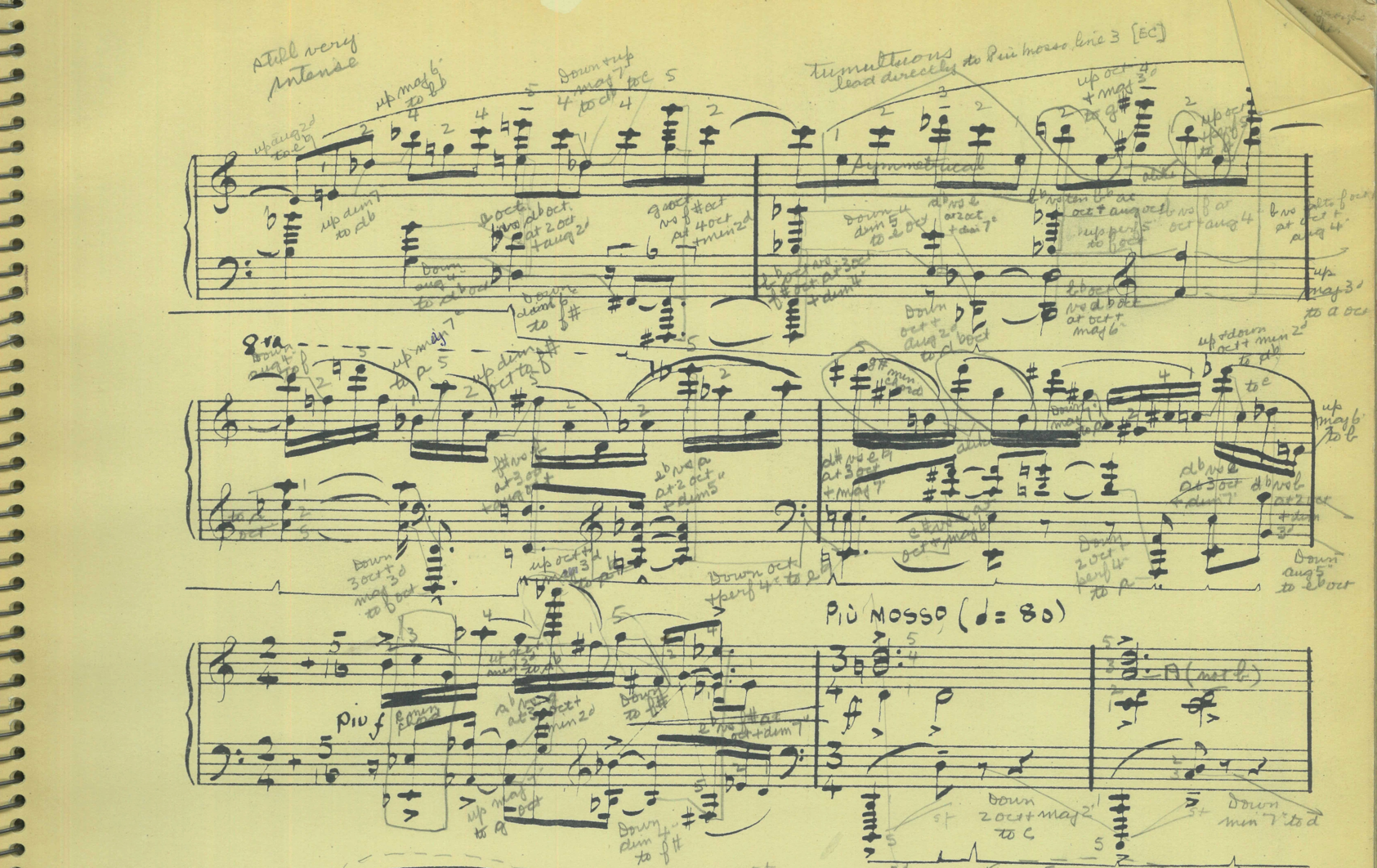
[ 4 ] Sykes himself was extraordinarily detailed in his annotation of the photostat. Every measure of the score contains many fingerings and indications of the intervals between notes and chords. For example, measures 3-4 (shown in Example 4) includes the pencil annotations: “Down min 7 to c♯; Down to g♯; Down 2 oct min 2 to a♯.” Almost every measure is filled with such annotations. Sykes also circles or boxes groups of notes adding comments such as “alike,” “compare,” and “symmetrical,” showing his considered analysis of the music he was playing. In Example 2a and 2b, we see that Sykes cross-referenced the return of the second movement’s opening chord with the comment “As if G maj chord, as at p.32 line 2” on page 17 and “As if G maj chord as at p. 17 1st meas” on page 32. Sykes also drew a box around these measures. Whether it was Carter who suggested thinking of these chords “as if G maj” or Sykes’s own way of making sense of the music is unclear and both possibilites would seem plausible. At various other places in the score we find such boxes around chords with similar annotations, such as Ex. 2c, line 2 m. 2 “As if eb min chord” and m. 3 “Cb maj chord.” But page 32 is most densely annotated with these observations: Sykes identifies another fifteen triad-like chords on this page including the one seen in Ex. 2b m. 3, which, together with its recurrence two measures later (not shown), he marks “As if Bb maj chords.”
Example 4
Piano Sonata Photostat, first page
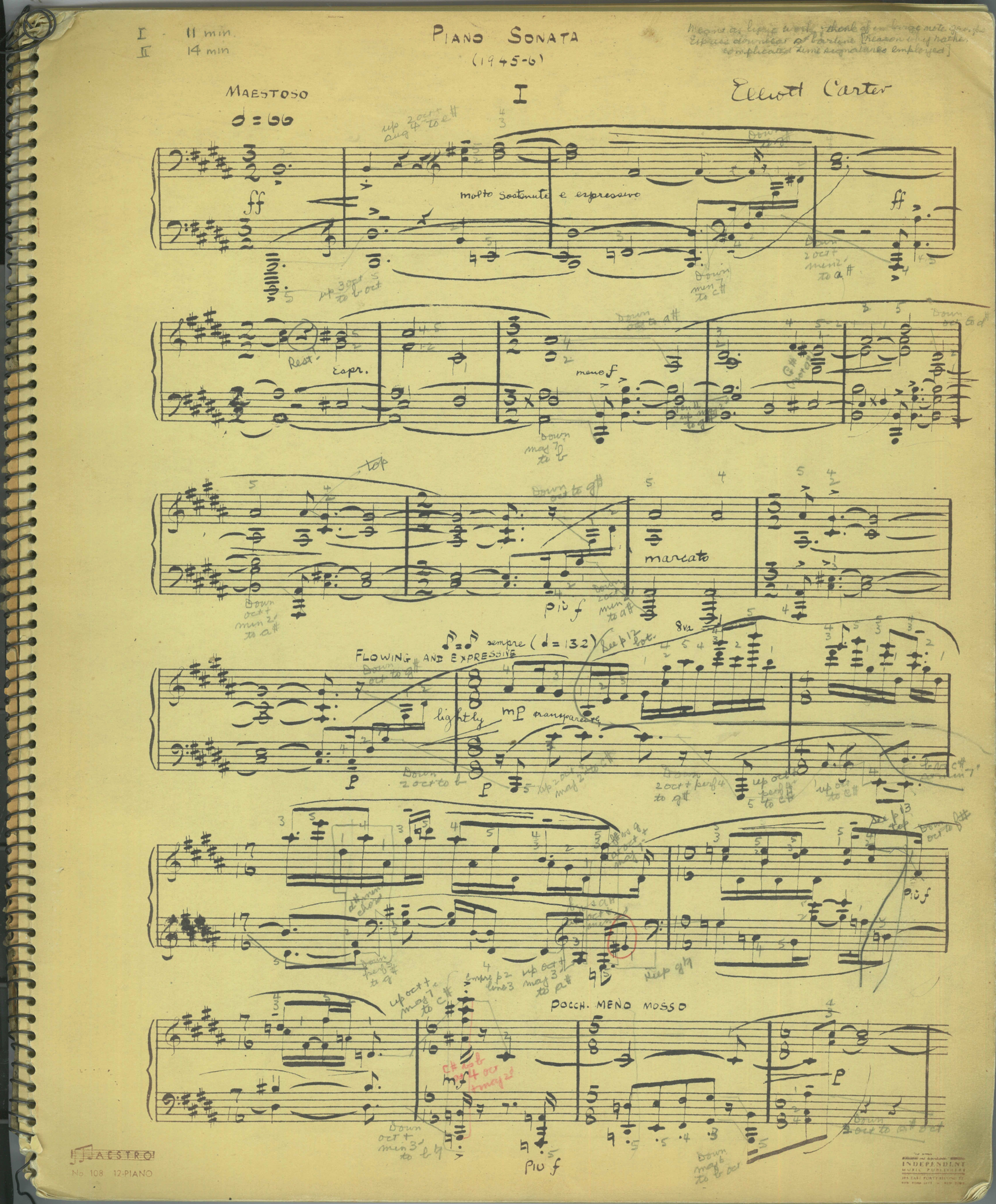
[ 5 ] The metrical notation in the photostat is interesting because it still contains the time signatures that Carter later removed before the first edition was printed. Example 4 shows Sykes’s notes at the top of the first page: “Meant as lyric work, think of in large note groups. Express downbeat at barline [reason why rather complicated time signatures employed].” (Brackets in the original.) Presumably this comment came out of a conversation with Carter at some stage during Sykes’s preparation of the piece.
[ 6 ] There are a number of corrections made to this photostat, implying that Carter was still revising the piece close to its scheduled performance. (Webster Aitkin must have also been preparing the piece at the same time.) The first correction is on page 12, line 2, where chords are added to what was originally eight measures of a single right hand decelerating melody with only one staccato chord accompanying a B4 in the fourth measure. The chords are written into the score in pencil and are identical to those that later appear in the printed score (see Example 5).
Example 5
Piano Sonata Photostat, p. 12 line 2 - changes copied in by Sykes

[ 7 ] Furthermore, the last three pages of Movement I in Sykes’s copy of the photostat (pages 14, 15 and 16) have been taped over by three revised photostat pages. On page 14, the sticky tape has come loose and we are able to see the previous photostat page to compare what was changed (see Examples 6a and 6b). The primary difference between the earlier photostat of this page and the new one is the written out “ornamentations” that Carter added. In the earlier photostat at 6 measures prior to “Tempo 1,” Carter had written a grace note pickup in both left and right hands. Sykes circled these notes and added the comment “ornament amended.” In the later photostat taped over the top of this page, we can see that Carter changed the rhythm to quintuplet thirty-second notes and thickened the texture considerably. Additionally at 5, 7 and 9 measures after “Tempo 1,” the sixteenths and thirty-seconds that are found in the taped-on page (and the printed score) are only acknowledged in the original photostat by Sykes’s annotations: an oval circle in each of the measures with the word “ornament” written above it. One could surmise that Carter had let Sykes know he had made revisions to a number of pages before he eventually sent him the corrected photostat and Sykes had noted the locations of these changes in his score. Sykes had likely already made enough annotations in his copy of the score that he preferred to continue using it and he taped the revised pages over the original ones rather than using the new copy.
Example 6a
Piano Sonata Photostat, page 14, version 1
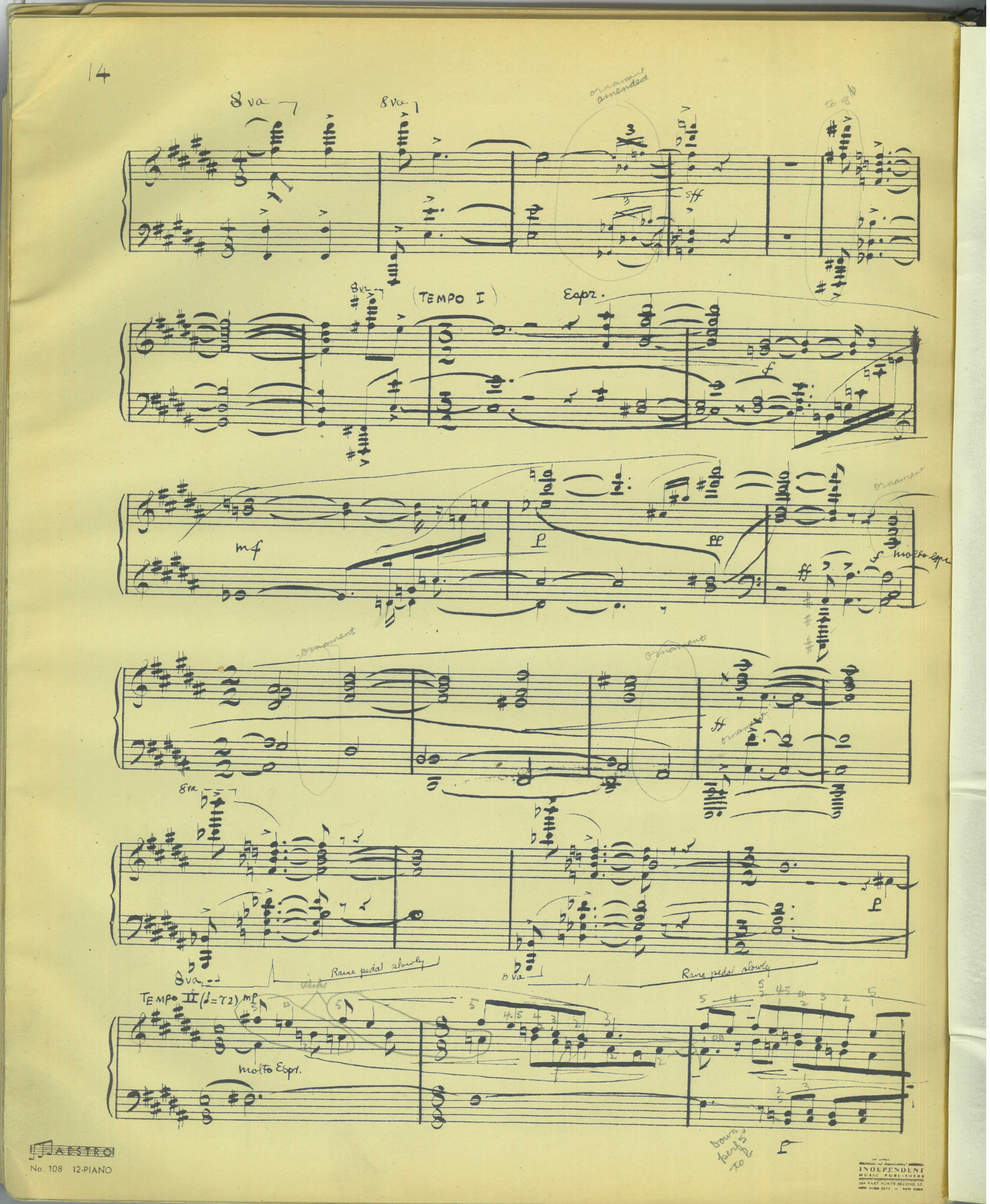
Example 6b
Piano Sonata Photostat, page 14, revised version 2
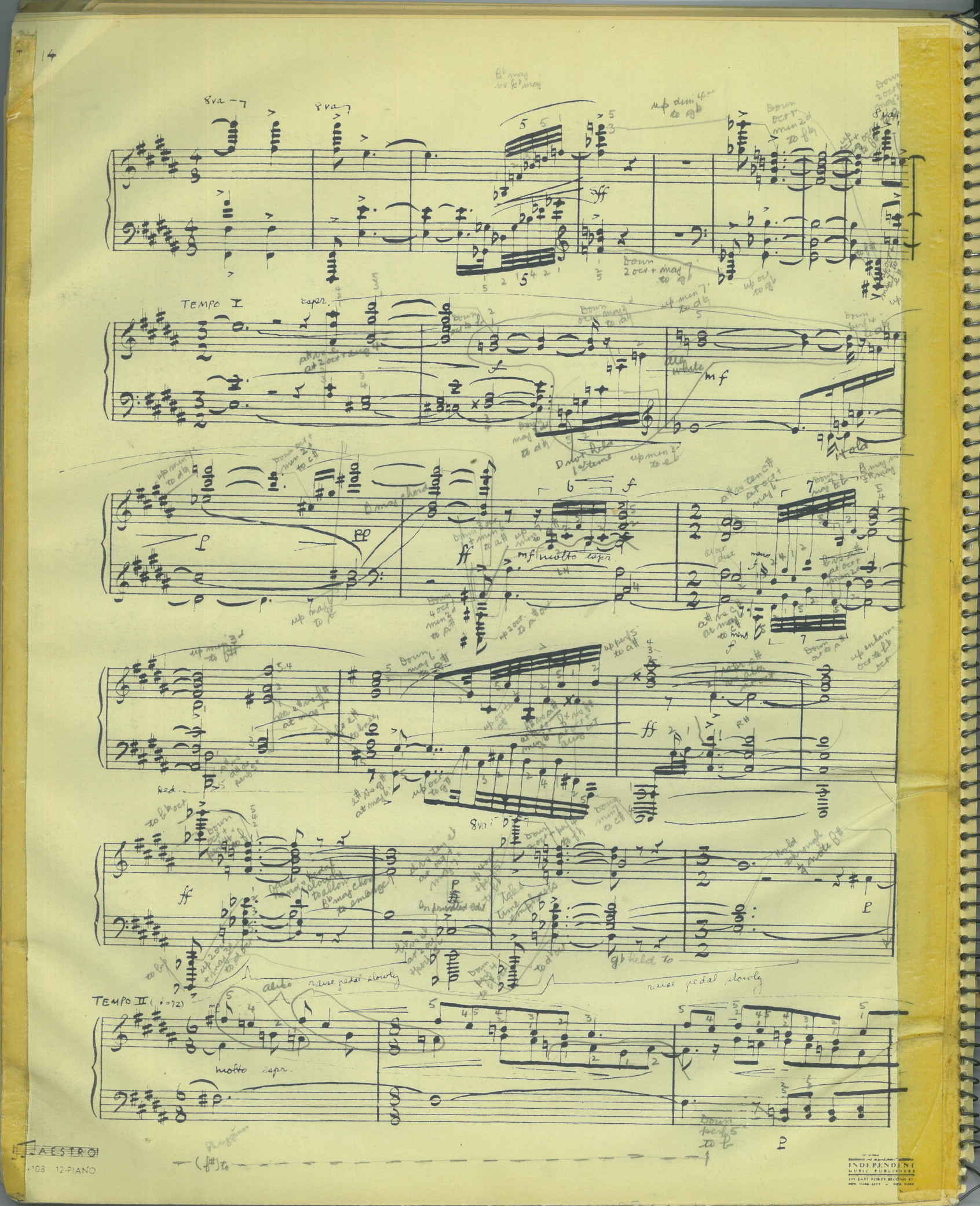
[ 8 ] Another significant revision that Carter made was to the final two measures of the piece. In Example 7 we can see that Sykes wrote out Carter’s revised final measures in pencil below the original ending. In this revision the last chord is renotated, shifting the lowest B octave one eighth note later to make a chord with the octave Bs above while bringing the D♯3 forward to the first beat of the measure and adding F2. Carter also lets the four-octave B chord ring on its own for an extra six quarter notes. Sykes copied out this ending exactly as it appears in Carter’s revised autographed photostat. This ending is closer to the one that makes it into the published score but it still differs from it: in the published edition, Carter keeps the right hand the same (assuming the missing stem in the second-to-last measure of Sykes’s transcription is an error), but makes two changes to the left hand part. Firstly he removes the lowest B that he had added in the second version of the ending. And secondly, he replaces the D♯-F♯ dyad on the left-hand downbeat with the lowest D♯ on the piano and makes it the same duration as the right hand chord, leaving only the two-octave Bs sounding at the end.
Example 7
Piano Sonata Photostat, last page: Carter’s revised ending added in pencil by Sykes

[ 9 ] The Paul Sacher Foundation holds copies of both photostat versions.(3)With thanks to Felix Meyer and Matthias Kassel for providing information on the holdings in the Elliott Carter Collection at the Paul Sacher Stiftung. The first version clearly shows Carter’s revisions. Carter wrote in purple pencil “revised” or “rewritten” at the top of pages 12, 14, 15, 16 and 34 (last page) and crossed out in pencil the relevant sections on each page. In Elliott Carter: A Centennial Portrait in Letters and Documents, Meyer and Shreffler reproduce the first page of a ring bound copy of the second version and on this copy we can see that Carter wrote in pencil at the bottom of the page “with changes – ending new.”(4)Meyer and Shreffler, A Centennial Portrait, 74.
[ 10 ] Sykes’s photostat copy of the score is an intriguing record of the work that Sykes and Carter put into the preparation of the first concert performance of Carter's Piano Sonata. Sykes’s detailed annotations show the dedicated time and effort that he gave to understanding the music he was playing, using the analytical tools with which he was familiar. The attribution to Carter of the many comments that Sykes wrote in the margins of the score is corroborated by Carter’s hand-written note taped to the back cover of Sykes’s score and both the score annotations and the note provide evidence of Carter’s on-going involvement as Sykes prepared the Piano Sonata’s concert premiere.
Footnotes
1. https://ead.dartmouth.edu/html/ms1007_fullguide.html
2. Felix Meyer and Anne Shreffler (eds.), Elliott Carter: A Centennial Portrait in Letters and Documents (Woodbridge: The Boydell Press, 2008), 73.
3. With thanks to Felix Meyer and Matthias Kassel for providing information on the holdings in the Elliott Carter Collection at the Paul Sacher Stiftung.